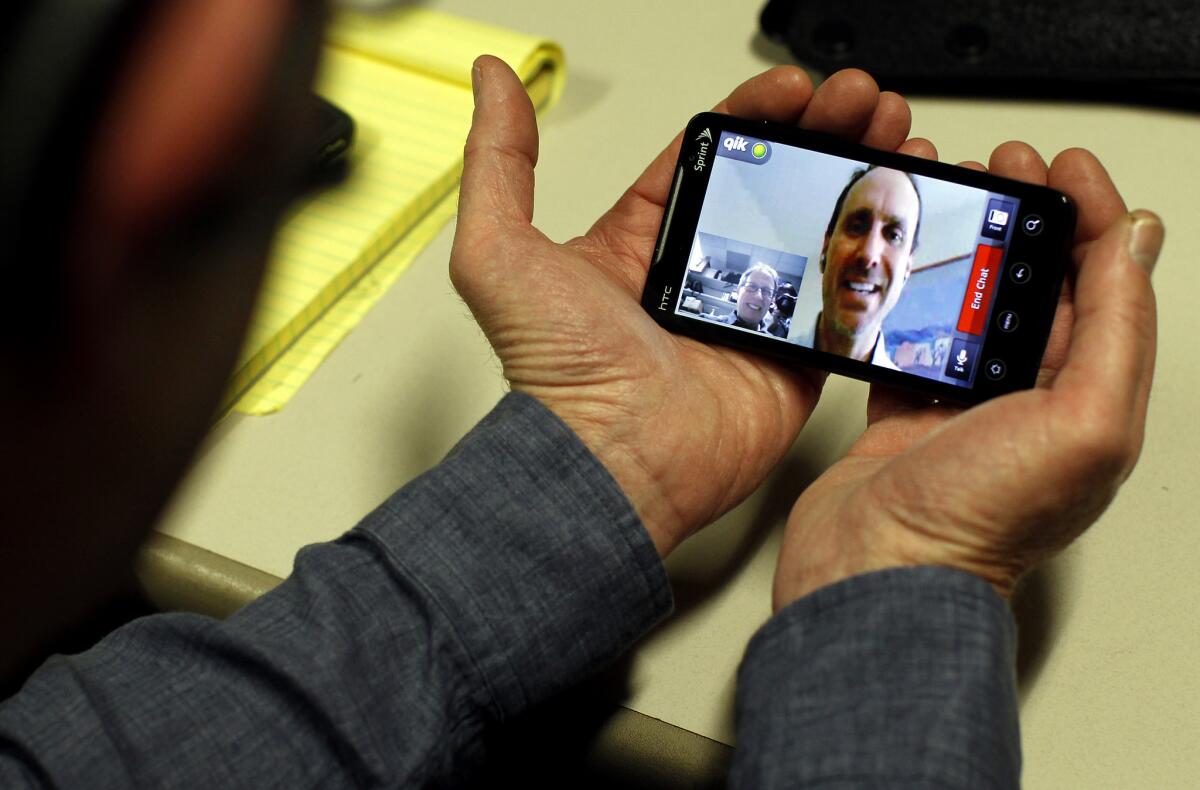Telehealth: Patient care via smartphone

File photo of a video chat.
If you can’t find a doctor who makes house calls, telehealth might be an appealing option.
Telehealth — using electronic information and telecommunications to support long-distance healthcare — was once primarily used by people in remote areas who might have to travel for hours to see a doctor.
But today, anybody with a smartphone can video chat with a medical professional about postpartum depression, a bout of rosacea or what’s causing that sudden weight gain.
According to a study released in 2013 by market research firm IMS Research, some 1.3 million people in the U.S. will use some form of telehealth by 2017 — up from the 227,000 people who tried it in 2012.
The American Medical Assn. favors the use of telemedicine to advance increased access, care coordination and quality, but patients should be aware of limitations of this kind of treatment, says AMA president Dr. Steven J. Stack.
“Patients should be informed about telemedicine, how it can impact their care and efforts to protect their privacy,” he said. He also counsels those looking to consult with doctors via teleconferencing to “be informed about the credentials and qualifications of the physician ... [and] have access to their health records.” In addition, he said, patients should be ready to be referred to see a doctor in person, if the case warrants it.
Until that face-to-face visit is called for, however, here are some ways to get non-emergency medical help:
— Maven, founded in April, bills itself as a “digital clinic for women.” Download the app and you have access to 400 pediatricians, gynecologists, doulas, lactation consultants and nutritionists around the country, many available to video chat within minutes.
“The majority of healthcare decisions in the U.S. are controlled by women,” said Katherine Ryder, Maven’s founder and chief executive. “I wanted to create a product that would help women make healthcare decisions and give them instant access when they needed it.”
Prices range from $18 for a 10-minute consultation with a nurse practitioner to $70 for a 40-minute chat with a mental health professional. Patients fill in a basic medical history online before speaking with the practitioner and then receive follow-up documentation afterward recounting what occurred during the conversation.
Ryder said that since the launch, Maven practitioners have consulted with women about concerns including postpartum depression, fertility treatments and how to jump-start a weight-loss plan.
— DermCheck was launched in July by Santa Monica dermatologist Ben Behnam. The app allows users to take photos of their acne, cold sore or rash and send it to a dermatologist for a flat fee of $39.95, which includes the consultation, diagnosis, prescription and follow-up. Cost of medication is extra.
The app can be used by people in California, New York and Florida, with more states to be added later this year.
Behnam said it is fairly easy for a doctor to determine by reviewing the initial photograph and responses to a questionnaire whether a condition needs further investigation. The company has also contracted with pharmacies to ship out the drugs a DermCheck dermatologist might prescribe.
“Our doctors have all the time in the world to stare at the multiple photos a patient sends in,” said Behnam. “It’s much easier to avoid the in-office chaos this way.”
— Those seeking spiritual counseling — including traumatized veterans and people struggling with cancer or other life-threatening conditions — can access the 54-year-old, New York-based HealthCare Chaplaincy Network’s video-chat facility free of charge. And religion has nothing to do with it, said Eric J. Hall, the network’s president and chief executive.
“Chaplaincy is everything but religion,” he said. “Chaplains are trained to walk into any situation — Buddhist, Muslim, someone with no belief system — and simply accept them where they are.” Although chaplaincy has historically been associated with last rites, Hall said there are “numerous situations in healthcare right now where people would benefit from a listening ear. That’s what healthcare is finding, across the field.” Chaplains in the network have helped with situations such as an injured athlete struggling to figure out what to do next or a person newly diagnosed with a serious health condition.
The video chat “is not meant to replace a chaplain making a physical visit,” said Hall. “But we have to recognize that there are numerous situations where that’s just not possible. And sometimes people like talking to a stranger because there’s a comfort there.”
ALSO:
Would you let someone zap your brain? Why ‘electronic brain stimulation’ is trending
Neuroplasticity - the brain’s ability to adapt - offers hope to those with debilitating diseases
Scratching your head over lice? You’re not alone, but experts say don’t panic
More to Read
Inside the business of entertainment
The Wide Shot brings you news, analysis and insights on everything from streaming wars to production — and what it all means for the future.
You may occasionally receive promotional content from the Los Angeles Times.










